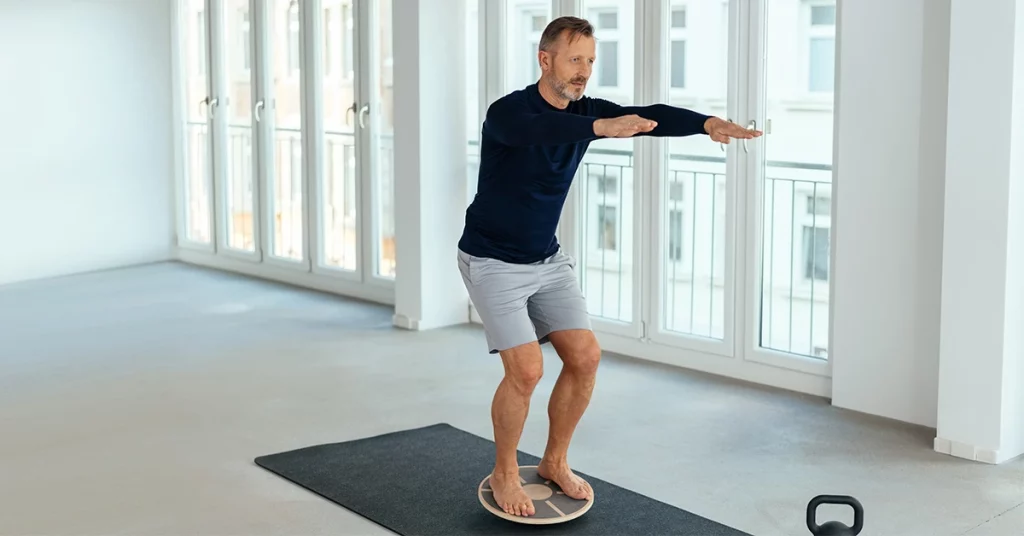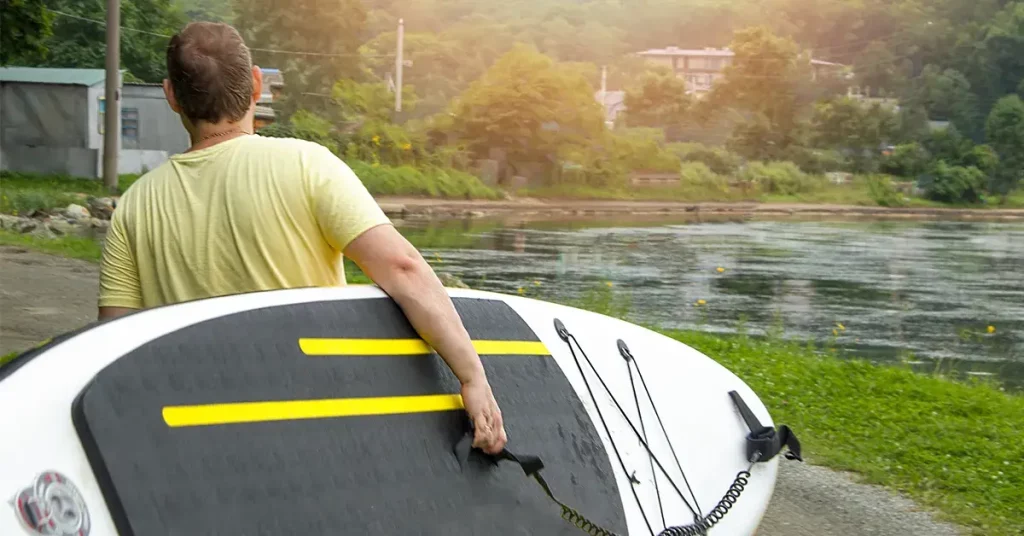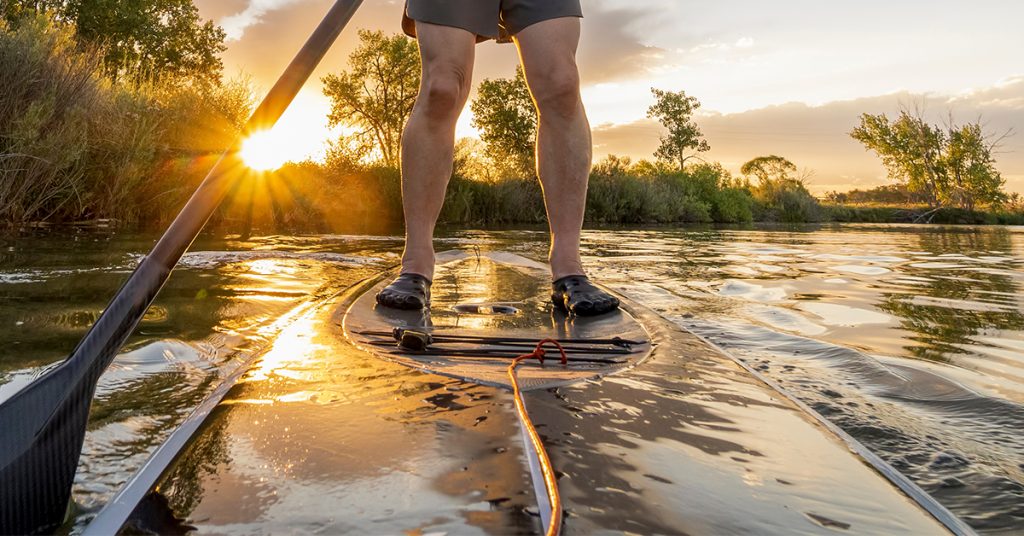Ideally, most of us would love to do paddle boarding training out on the water. However, there are many reasons you may want to learn how to do indoor paddle board training on your own.
Real life is great at getting in the way of the things you want to spend time doing, so indoor paddle board training is often necessary to build your SUP fitness and skills so you can get more enjoyment out of future outdoor outings.
With a list of good exercises on hand and just some basic equipment, surf and SUP athletes can take steps toward being their best without even touching a drop of water.
In this article, we are going to provide some practical indoor training advice to help take your stand up paddle boarding experience to a new level.
Physical Challenges of Paddle Boarding

It’s nearly impossible to craft a smart training routine if you don’t first know what will be required of your body during a given activity. Sure, you’ll be in a standing position while on your board, but what muscle groups are going to be engaged? What body movements will be required to move along the way without falling in?
The list below highlights the main challenges you will face.
It Demands Core Strength
Perhaps the most important thing you can take away from this article is that SUP places huge demands on your core strength. Your abs and the rest of the muscles in the middle of your body need to be up to the challenge if you are going to have fun in this sport. SUP enthusiasts all know that the core is the primary place to focus training efforts. While on the water, a stand up paddle board is an unstable surface, and it is your core that is primarily responsible for steading your balance and keeping you up in a standing position.
Flexibility Matters
Along with core strength, it’s a good idea to focus on flexibility in your training efforts. There are quite a few benefits to increasing your flexibility, from being able to bend and reach further in all directions to the ability to avoid injury. And, when you are more flexible, you might avoid some of the delayed onset muscle soreness that could come from forcing your body into uncomfortable positions. That means less time at home nursing soreness and more time out having fun on your board.
Build Upper Body Strength
Finally, creating gains in upper body strength through your training program will also pay off in your SUP performance. The upper body is the engine of your board, allowing you to make powerful strokes over and over again. It’s not only swimmers who need strong shoulders and upper back muscles– stand up paddle board enthusiasts can benefit here, as well. You’ll notice that a lot of paddle drills focus on developing strength in your upper body, and that’s no coincidence — your power output will improve with more upper body strength, and that means you’ll be able to go further and faster than before.
Benefits of Indoor Paddle Board Training

Training indoors pays off in many different ways. While it would be nice if you could do all your training outdoors, that probably isn’t practical and will make it hard to get in all of your workouts. The more stand up paddle board fitness tips you read, the more you will find about the benefits of staying inside.
For one thing, training for stand up paddle boarding inside offers a controlled environment. You don’t have to worry about the conditions getting in the way of your plans while indoors, so you can just focus on executing the movements and improving your balance, technique, and strength. Much like a golf swing can be improved away from the course, paddle board technique can be optimized even with no water in sight.
There are many options for indoor SUP training, including using an indoor stand, a rowing machine to build muscle, or even an incline bench. You can choose to build your own indoor training program or you can work with a SUP instructor who could help you build a plan that can be executed week after week throughout the year.
4 Exercises to Prep You for Paddle Boarding

It’s likely that you’ll want to customize your routine to improve your SUPing, and there are unlimited workouts out there to consider. However, we wanted to get you started by going over a list of four exercises that can easily be done indoors with the goal of making you a better paddle boarder. If you don’t have much experience working out on your own, retaining the help of a personal trainer could be a wise investment.
#1 Single-Leg Deadlifts
This is an excellent option for paddleboarding and for overall fitness.
Holding a weight in one hand– or starting out with no weight– tilt down toward the floor with your upper body, keeping the leg opposite the weighted hand on the ground while the other leg moves back. This is a good exercise for SUPing because it prioritizes both core strength and balance training. To go through a few sets of this exercise will require you to stay focused on your balance and engage the muscles throughout the middle of your body.
#2 Body Weight Squats
If you are at all familiar with fitness routines, you won’t be surprised to find a squatting motion on this list. Squats are good for just about everything, and this sport is certainly no exception. Since paddleboarding is so much about remaining balanced and in control of your body, body weight squats are a great way to work toward those goals.
Just stand with your feet flat on the ground and slightly flared out while you bend your knees to squat and your back remains straight. For a more advanced move, you could do single-leg squats, and you could add weights to the equation, as well.
#3 Planks
Getting right to the central theme of core strength– with your abdominal muscles being the best of your stabilizer muscles– planks are an excellent exercise to include in your routine and they only take a few minutes to perform.
Since no equipment is required, you can planks wherever you happen to be. Start with a traditional plank, where you support your body in a push-up position, but only your elbows instead of your hands. Hold there for a certain amount of time – 10 seconds for a beginner, longer as you build strength – and then rotate to your left side and right side for side planks.
#4 Rows
While stand up paddle boarding is not the same as rowing, and you don’t need immense upper body strength, there is a big element of shoulder and back strength that comes into play. Therefore, think of an exercise with a rowing aspect as a useful one to include in your routine.
This can be executed in a number of different ways, including using a rowing machine, using free weights, or using a cable machine at a gym. Whatever your choice, be sure to execute the move slowly and in a controlled manner to build strength while limiting the risk of injury.
Build an Indoor Training Schedule

As with any fitness regime, you are only going to see progress if you are able to stick to a consistent, repeatable schedule.
That schedule needs to be designed so that it doesn’t get in the way of your day to day life.
As a general rule of thumb, try to get in at least two exercise sessions per week, if not three. At the start, you might find that there is quite a bit of soreness in your body the day or two after your workout, but that should quickly get better since you aren’t lifting with heavy weights (at least, not if you use the example exercises we provided). Of course, if you use free weights of an exercise device to lift heavier, adjust your soreness expectations accordingly.
As far as timing your workouts around paddleboard outings, it’s probably fine to work out the day before a trip out on the water, but don’t expect to do much in the way of targeted exercise the day after. You will probably be pretty sore from the paddleboarding itself, so adding a workout onto it might not be the best idea.
Get Started Right Away

Whether you are going to focus on strengthening your abdominal muscles to build core strength, doing some SUP yoga as balance training, or using any other methods to get better at this sport, starting right away is key. Indoor paddle board training workouts can not only pay off in a big way, but they can be fun, as well.
We hope this article helps to get you up and SUPing in no time, and good luck with your training!




